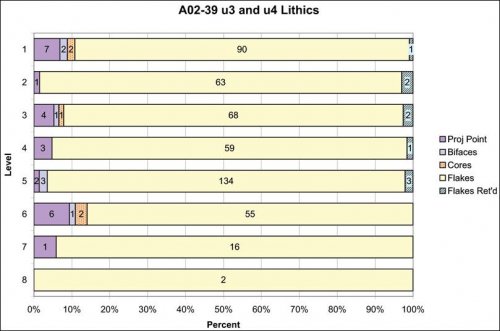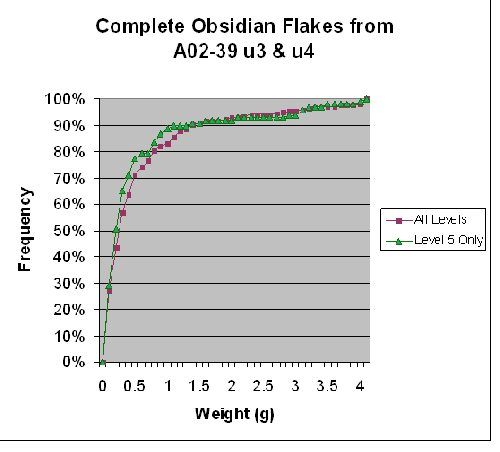Artifacts by level
|
Level |
Proj Points |
Bifaces |
Cores |
Flakes |
Flakes Retouched |
Groundstone |
|
1 |
7 |
2 |
2 |
90 |
1 |
|
|
2 |
1 |
63 |
2 |
|||
|
3 |
4 |
1 |
1 |
67 |
2 |
|
|
4 |
3 |
59 |
1 |
|||
|
5 |
2 |
3 |
134 |
3 |
||
|
6 |
6 |
1 |
2 |
55 |
1 |
|
|
7 |
1 |
16 |
||||
|
8 |
2 |
|||||
|
Total |
24 |
7 |
5 |
486 |
9 |
1 |
Table 7-29. A03-39u3/u4 counts of lithics by level.
Figure 7-34. A02-39u3/u4 Bar graph showing counts of lithics classes by excavation level.
Classes of lithics from A02-39u3 and u4 show that demonstrable variability was occurring in activities in this area. All of the diagnostic projectile points were Series 5 points, all points were made from Ob1 obsidian except for one Ob2 point, and 80% of the points were broken. The complete points were found scattered in every level, and the series 5 types are consistent with the Late Formative dates from radiocarbon dating. Some of the points were extremely small, including one beautifully pressure flaked point [L03-60.3] that measured only 12.9mm long by 5.2mm wide, and 2.9mm thick weighing 0.1 g. The other points were all very small, with a mean weight of 0.6 grams, which suggests that the size of the projectile is not necessarily related to material abundance as obsidian was abundant at this location in the Late Formative and yet the projectile points were extremely small.
|
Level |
Complete Flakes |
Pressure |
% Pressure by Row |
Observed BTF |
Calculated BTF |
% Calculated |
|
2 |
46 |
1 |
2.1 |
1 |
5 |
10.9% |
|
3 |
45 |
2 |
4.3 |
1 |
8 |
17.8% |
|
4 |
41 |
0 |
2 |
10 |
24.4% |
|
|
5 |
97 |
1 |
1.0 |
3 |
18 |
18.6% |
|
6 |
36 |
0 |
1 |
2.8% |
||
|
7 |
6 |
0 |
2 |
33.3% |
||
|
Total |
271 |
4 |
- |
7 |
44 |
- |
Table 7-30. A02-39u3 and u4: Obsidian flake types by excavation level.
In level 5, between 50 and 60 cm depth and associated with the F1 hearth feature in south half of Unit 4, a distinct increase in obsidian reduction activity was encountered that suggests more advanced reduction activity was occurring in this period. Focusing only on complete obsidian flakes, reveals a much higher count of complete flakes per unit volume of dirt, a quantity that was more than double the number in other levels.
Leaving out level 1 due to surface contamination, the evidence from complete flakes suggests that while bifacial reduction was occurring in level 5, pressure flaking was relatively rare. Bifacial thinning flakes were noted by one of the analysts (Mackay) in the process of labwork (observed BTF column) but because other analysts were not making note of BTF during analysis, additional candidates for inclusion in the BTF category based on the BTF calculation model presented above appear in the column labeled "Calculated BTF". Both observed BTF and calculated BTF values suggest that during level 5 distinctive reduction activities occurred.
Figure 7-35. Cumulative Frequency of A02-39 u3 & u4 showing Level 5 reduction against reduction for all levels.
Figure 7-35 shows that there was a larger number of very small flakes in level 5, where over 75% of the complete flakes weighed less than 0.6 grams. Evidence of the conservation of material appears in levels 4 and 5, where complete flakes have a higher mean number of rotations and much smaller platform sizes. Finally, the mean coverage of dorsal cortex on flakes decreased from 6.9% in level 5 to 4.3% in level 4, while 6.4% is the mean for these units. In other words, there was a slightly greater range of reduction levels occurring in level 5 where there was more cortex but also a great many small flakes. By the next level, level 4, there was primarily decorticated material in use, and relatively little cortical obsidian.
Other artifacts include bone and ceramics throughout the sequence, and a few tiny pieces of turquoise in level 6 at the bottom of the hearth. Ceramics were found in every level in these excavation units, but few of them were diagnostic. Of the 38 sherds only four were rim sherds and two were handle pieces. One sherd found in level 5 had an incised line parallel to the rim, but was otherwise non-diagnostic. Five sherds from the lower levels (level 3, 5, and 7) resemble the "Chiquero" style described by Wernke (2003) with a brushed interior and no slip. Bone fragments were found in every level but none were diagnostic. Burned bone and charcoal in grey soil were found in particularly high density in hearth F1, along with a broken piece of groundstone and fire-cracked rock.


